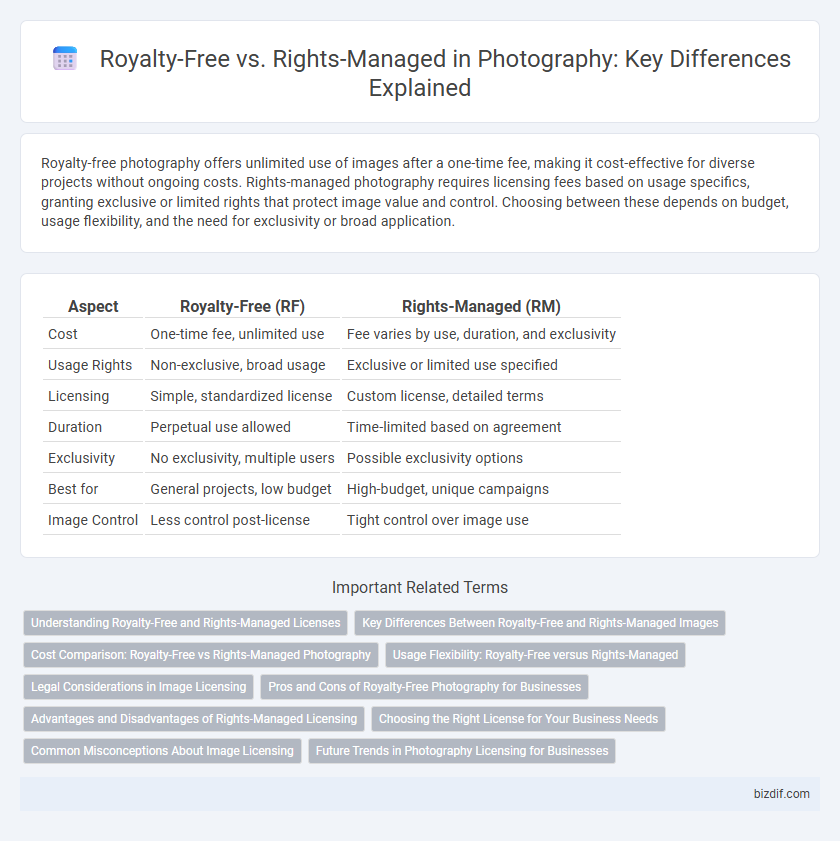Royalty-free photography offers unlimited use of images after a one-time fee, making it cost-effective for diverse projects without ongoing costs. Rights-managed photography requires licensing fees based on usage specifics, granting exclusive or limited rights that protect image value and control. Choosing between these depends on budget, usage flexibility, and the need for exclusivity or broad application.
Table of Comparison
| Aspect | Royalty-Free (RF) | Rights-Managed (RM) |
|---|---|---|
| Cost | One-time fee, unlimited use | Fee varies by use, duration, and exclusivity |
| Usage Rights | Non-exclusive, broad usage | Exclusive or limited use specified |
| Licensing | Simple, standardized license | Custom license, detailed terms |
| Duration | Perpetual use allowed | Time-limited based on agreement |
| Exclusivity | No exclusivity, multiple users | Possible exclusivity options |
| Best for | General projects, low budget | High-budget, unique campaigns |
| Image Control | Less control post-license | Tight control over image use |
Understanding Royalty-Free and Rights-Managed Licenses
Royalty-free licenses allow photographers and buyers to use images multiple times without paying additional fees, offering flexibility and cost-effectiveness for ongoing projects. Rights-managed licenses restrict image usage based on specific terms such as duration, geographic region, and media type, ensuring controlled and exclusive use tailored to the buyer's needs. Understanding these licensing types helps photographers maximize earnings while guiding clients on legal image use for marketing, editorial, or commercial purposes.
Key Differences Between Royalty-Free and Rights-Managed Images
Royalty-free images offer a one-time purchase with unlimited use across multiple projects without additional fees, while rights-managed images require licensing for each specific use, limiting exclusivity and duration. Royalty-free licenses prioritize cost-effectiveness and ease of access, making them ideal for businesses seeking broad usage, whereas rights-managed licenses provide control over how and where images are used, ensuring exclusivity and tailored rights. Understanding these differences helps photographers and buyers select appropriate licensing based on budget, usage needs, and desired image control.
Cost Comparison: Royalty-Free vs Rights-Managed Photography
Royalty-free photography offers a one-time payment model, providing unlimited use without recurring fees, making it cost-effective for businesses with repetitive image needs. Rights-managed photography requires licensing fees based on usage scope, duration, and distribution, often resulting in higher initial costs but more controlled image exclusivity. Budget planning should consider frequency of use, exclusivity requirements, and long-term financial impact between these two licensing structures.
Usage Flexibility: Royalty-Free versus Rights-Managed
Royalty-free images offer greater usage flexibility by allowing buyers to use the photo multiple times across various projects without paying additional fees, making them ideal for ongoing marketing campaigns and broad distribution. Rights-managed images require specific usage terms and fees based on factors like media type, duration, and geographic region, providing more control but limiting how and where the image can be used. This distinction impacts project budgeting and licensing strategy, influencing whether a photographer or company opts for predictable costs or tailored exclusivity.
Legal Considerations in Image Licensing
Royalty-Free licenses provide broad usage rights for a one-time fee without time limits, simplifying legal clearance for most commercial and editorial purposes. Rights-Managed licenses require specific usage terms, duration, and geographic limits, offering more controlled legal protection but with detailed contract obligations. Understanding these distinctions ensures compliance with copyright law and mitigates risks of unauthorized image use or infringement claims.
Pros and Cons of Royalty-Free Photography for Businesses
Royalty-Free photography offers businesses cost-effective and flexible usage rights, allowing multiple uses across various projects with a single purchase, which enhances budgeting efficiency. However, its broad licensing can limit exclusivity, increasing the risk of repetitive imagery in competitive markets. Additionally, Royalty-Free images may lack customization options, reducing brand uniqueness compared to Rights-Managed content.
Advantages and Disadvantages of Rights-Managed Licensing
Rights-managed licensing offers precise control over image use, allowing photographers to set specific terms like duration, region, and media, which can maximize revenue by tailoring fees to each use. However, this licensing can be restrictive for buyers, limiting flexibility and potentially deterring clients seeking broader usage rights. The trade-off includes higher licensing fees and exclusive use options for rights-managed images, balancing tighter control with the complexity of negotiating individual licenses.
Choosing the Right License for Your Business Needs
Selecting the appropriate photography license depends on your business goals and usage requirements. Royalty-Free licenses offer flexible, cost-effective access with multiple uses after a one-time fee, ideal for broad marketing campaigns and consistent content needs. Rights-Managed licenses provide tailored usage rights with specific limitations, perfect for exclusive projects requiring controlled distribution and high-value exclusivity.
Common Misconceptions About Image Licensing
Many assume royalty-free images are completely free, but they require a one-time payment allowing multiple uses without additional fees, unlike rights-managed images that offer limited, specific usage rights for each license. Royalty-free licensing does not mean unlimited usage; restrictions often apply to context, distribution methods, and geographic regions. Misunderstanding these distinctions can lead to legal risks and unanticipated costs in commercial photography projects.
Future Trends in Photography Licensing for Businesses
The future of photography licensing for businesses is shifting toward more flexible models that combine the broad usability of royalty-free licenses with the tailored restrictions of rights-managed options. Advances in AI-driven licensing platforms will enable precise usage tracking and customized pricing, offering businesses better control and cost efficiency. Emerging trends also emphasize sustainability and ethical sourcing, prompting greater demand for transparent licensing agreements that protect photographers' rights while meeting corporate social responsibility goals.
Royalty-Free vs Rights-Managed Infographic

 bizdif.com
bizdif.com